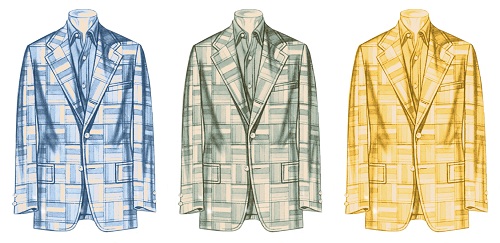Lightweight and breathable in bright, saturated colors, madras may just be the perfect summer fabric. A true preppy classic, it adds a little pop and laid-back style to any outfit — and fits the season’s easy-breezy feeling to a T. Madras has been a part of Brooks Brothers’ legacy for nearly a century. Join us as we delve into the history of summer’s favorite fabric.
Lightweight and breathable in bright, saturated colors,
madras may just be the perfect summer fabric. A true preppy classic, it adds a
little pop and laid-back style to any outfit — and fits the season’s
easy-breezy feeling to a T. Madras has been a part of Brooks Brothers’ legacy
for nearly a century. Join us as we delve into the history of summer’s favorite
fabric.
But first, what is madras?
Madras refers to a lightweight fabric made from fine cotton that has been
yarn-dyed and woven to create vivid plaid so that the pattern is visible on
both front and back. Historically, the dyes used were prone to bleeding (keep
that in mind; it becomes important later). The fabric itself originated in the
city of Madras, now called Chennai, in India, from whence it gained its name.
As early as the 1600s, there
was rampant desire in Europe for the light, gauzy cottons produced in India.
When the British East India Company occupied the area and established
Fort St. George, they turned the local textile trade into a booming export
business. It is likely here that the fabric obtained its traditional plaid
pattern, either through the Scottish soldiers stationed in the area or a craze
for plaids, which began in 1822 after King George IV’s visit to Scotland.
Madras
continued to be popular throughout the 19th century, prized in
those pre-air-conditioning days for its breathable nature, which made hot
summers more bearable. By the turn of the 20th century, madras
was a well-established element of wardrobes in the warmest parts of Atlantic
tropics.
It is here
that madras enters the Brooks Brothers story. By the dark days of the 1930s,
leisure jaunts to the warm shores of the Carribbean had become something of a
status symbol, and those returning from these pleasure trips brought home the
breezy madras shirts they’d acquired as the perfect souvenir from an exotic
vacation. Brooks Brothers noticed the demand — and the utility of the fabric —
and became one of the first retailers in the United States to incorporate
madras into its warm weather offerings, proudly popularizing the fabric on
these shores.

By the dawn of
the 1960s, madras madness was sweeping the nation. The Ivy look was all the
rage, as more and more Americans attended college during postwar prosperity and
campus culture set the trends. Madras shirts became a huge part of that. At the
time, the natural dyes used by the Indian weavers were extremelyprone
to bleeding when damp, blending the bright plaids into a new, more muted design
that was unique on every shirt. Those who lived through this craze tell stories
of teen boys suddenly obsessed with laundering their shirts just so (probably
a welcome development for their mothers) to obtain the perfect amount of bleed.
To this day, madras continues to be a staple of the warm-weather wardrobe, in both whole cloth and patchwork iterations. (But don’t worry about the state of your laundry; we’ve solved the dye-bleeding problem.) Add a touch of history to your summer wardrobe with our newest madras offerings this season.
Brooks Brothers Vietnam:
- HCM: L1 – 19 & 20, Saigon Centre, 65 Le Loi, District
1 – ☎ (028) 3939 0477
- Hanoi:
31 Hai Ba Trung, Hoan Kiem Ward – ☎ (024)
3266 8206